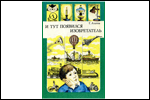
|
|
BOOKS AND ARTICLES
ALL IMMENSE PHYSICS
Books and articles / And then came the inventor
Henri Grizhot, a patient in a psychiatric clinic, invented ... hard water. Not ice, but solid water, which would not melt at least up to 200 degrees. And it succeeded... in the fantastic story of the Polish writer Stefan Weinfeld "Crazy". Grijot received a white powder-like powder. With strong heating, the powder turned into ordinary pure water. The story was published in 1964. And three years later, they actually invented hard water, consisting of a mixture of 90 percent water with 10 percent silicic acid. Solid water really turned out to be like white powder. The question may arise: why do we need solid water? Let's give the floor to Henri Grizhot: "My invention will make it possible to build factories in areas rich in minerals, but poor in water; now it is delivered in expensive tanks, but they will be sent simply in paper bags. Trade? Glass, ceramic and metal vessels for all kinds of liquids will completely disappear "Liquids will be sold as powders containing dry water...Thousands, tens of thousands of uses of dry water in ordinary life will lead to a complete revolution. Using water in a liquid state will be as funny as using a torch." Scientists are striving to obtain solid water that would contain only two to three percent silicic acid. There is nothing about this in physics textbooks. Physics is developing very rapidly, new effects and phenomena are being discovered all the time. Can you imagine how important it is for inventors to know about these new discoveries? Here is a typical story. While some scientists tried to make water more solid, others were looking for ways to make water more ... liquid. In 1948, the English scientist V. Tome discovered an amazing physical effect: the friction of water on the walls of a water pipe can be drastically reduced by adding an insignificant amount (hundredths of a percent) of some polymers to the water. Friction is largely caused by the formation of vortices in a fast-moving stream, and long polymer molecules, located along the stream, dampen vortices, streamline the movement of water, make water more slippery ... The message about the Toms effect was published, and soon many inventions appeared that used the new opening. The Toms effect helped to increase the speed of ships, reduce energy losses during the transportation of various liquids through pipes, and increase the "range" of fire hoses. And recently, inventors from Moscow State University proposed adding polymers to ... ice on skating rinks. High pressure is created under the blade of the skate, the ice melts, a thin layer of water lubricant is formed, which allows the skater to glide on the ice. The polymer added to the ice goes into this lubricant and reduces friction. There are many such examples. The inventor needs all the boundless physics - thousands and thousands of effects and phenomena. You can object: no physicist knows all of physics, because there are so many sections in it. An inventor cannot be required to know physics better than physicists. Yes, of course, you can not embrace the immensity. The way out is to create detailed reference books on the inventive application of physical effects and phenomena. Approximately the same as we did with the corona discharge, only, of course, much more detailed and accurate. The first reference books on "inventive physics" appeared in the early 70s. They described the inventive possibilities of many physical effects. It would seem that after this, reference books on combinations of effects should appear. But such guides do not yet exist. Too many possible combinations... Here, for example, is such a phenomenon as the polarization of light. We know that light is an electromagnetic wave. By passing light through certain substances, it can be polarized: oscillations will occur in one plane, for example, in a vertical one. The second phenomenon: there are crystals that rotate the plane of polarization of light. The thicker the plate of such a crystal, the more the plane of polarization of the polarized light passing through the plate rotates. The third phenomenon (it is familiar to you): when heated, the body expands. Combine these three phenomena - you get ... a thermometer. The higher the temperature, the greater the thickness of the plate and, consequently, the greater the angle of rotation of the polarized light passing through the plate. The laws by which such combinations of physical effects are formed are not yet entirely clear. Here today is the cutting edge of research on the theory of inventive problem solving.
Machine for thinning flowers in gardens
02.05.2024 Advanced Infrared Microscope
02.05.2024 Air trap for insects
01.05.2024
▪ Silver nanowire instead of ITO film ▪ New DC/DC converter from Texas Instruments
▪ section of the Electrician website. PTE. Article selection ▪ Affluent society article. Popular expression ▪ article What is extrasensory perception? Detailed answer ▪ article Holly. Legends, cultivation, methods of application ▪ article Compositions for blackening the skin. Simple recipes and tips
Home page | Library | Articles | Website map | Site Reviews www.diagram.com.ua |






 Arabic
Arabic Bengali
Bengali Chinese
Chinese English
English French
French German
German Hebrew
Hebrew Hindi
Hindi Italian
Italian Japanese
Japanese Korean
Korean Malay
Malay Polish
Polish Portuguese
Portuguese Spanish
Spanish Turkish
Turkish Ukrainian
Ukrainian Vietnamese
Vietnamese


 See other articles Section
See other articles Section 